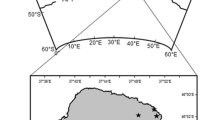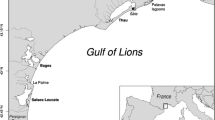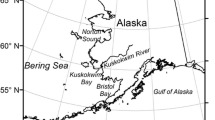Abstract
The cuttlefish Sepia apama Gray (Mollusca: Cephalopoda) is a seasonally abundant food resource exploited annually by moulting albatrosses throughout winter and early spring in the coastal waters of New South Wales, Australia. To assess its nutritional value as albatross forage, we analysed S. apama for water, lipid protein, ash contents, energy density and amino acid composition. Because albatrosses consistently consume S. apama parts preferentially in the order of head, viscera and mantle, we analysed these sections separately, but did not identify any nutritional basis for this selective feeding behaviour. The gross energy value of S. apama bodies was 20.9 kJ/g dry mass, but their high water content (>83%; cf <70% for fish) results in a relatively low energy density of 3.53 kJ/g. This may contribute to a need to take large meals, which subsequently degrade flight performance. Protein content was typically >75% dry mass, whereas fat content was only about 1%. Albatrosses feed on many species of cephalopods and teleost fish, and we found the amino acid composition of S. apama to be comparable to a range of species within these taxa. We used S. apama exclusively in feeding trials to estimate the energy assimilation efficiency for Diomedea albatrosses. We estimated their nitrogen-corrected apparent energy assimilation efficiency for consuming this prey to be 81.82 ± 0.72% and nitrogen retention as 2.90 ± 0.11 g N kg−1 d−1. Although S. apama has a high water content and relatively low energy density, its protein composition is otherwise comparable to other albatross prey species. Consequently, the large size and seasonal abundance of this prey should ensure that albatrosses remain replete and adequately nourished on this forage while undergoing moult.
Similar content being viewed by others
Abbreviations
- AA:
-
Amino acid
- AE:
-
Apparent energy assimilation efficiency
- AEn :
-
Nitrogen-corrected apparent energy assimilation efficiency
- PUFA:
-
Polyunsaturated fatty acid
References
Association of Official Analytical Chemists (AOAC) (1980) Official methods of analysis of the Association of Official Analytical Chemists. Association of Official Analytical Chemists, Washington, DC
Battam H, Smith LE (1994) Report on review and analysis of albatross banding data held by Australian Bird and Bat Banding Schemes. Australian National Park and Wildlife Service research consultancy agreement No 134, Canberra
Battam H, Chappell MA, Buttemer WA (2008) The effect of food temperature on post-prandial metabolism in albatrosses. J Exp Biol 211:1093–1101
Boyle PR (1987) Cephalopod life cycles. San Diego, Academic Press
Brekke B, Gabrielsen GW (1994) Assimilation efficiency of adult Kittiwakes and Brünnich’s Guillemots fed capelin and Arctic cod. Polar Biol 14:279–284
Cherel Y, Klages N (1998) A review of the food of albatrosses. In: Robertson G, Gales R (eds) Albatross biology and conservation. Surrey Beatty, Sydney, pp 113–136
Clarke A, Prince PA (1980) Chemical composition and calorific value of food fed to mollymawk chicks Diomedea melanophris and D. chrysostoma at Bird Island, South Georgia. Ibis 122:488–494
Clarke MR, Croxall JP, Prince PA (1981) Cephalopod remains in regurgitations of the wandering albatross Diomedea exulans L. at South Georgia. Br Antarct Surv Bull 54:9–21
Connell JJ, Howgate PF (1959) Studies of the proteins of fish skeletal muscle. J Biol Chem 71:83–86
Cooper J (1979) Length-mass relationships, water content and energy values for two species of squid, Loligo reynaudi and Todaropsis eblanae, off the South-western Cape. Fish Bull S Afr 11:43–45
Cooper JP, Henley SR, Klages NTW (1992) The diet of the wandering albatross Diomedea exulans at subantarctic Marion Island. Polar Biol 12:477–484
Coppini R (1972) Determinazione e comparazione del valore nutritivo e del valore commerciale di alcune specie di Molluschi eduli dell’Adriatico. Ateneo Parmese Acta Naturalista 8:51–65
Croxall JP, Prince PA (1982) Calorific content of squid (Mollusca: Cephalopoda). Br Antarct Surv Bull 55:27–31
Croxall JP, Prince PA (1996) Cephalopods as prey. I. Seabirds. Philos Trans R Soc Lond B 351:1023–1043
Friedman M (1996) Nutritional value of proteins from different food sources. A review. J Agric Food Chem 44:6–29
Gibson JD (1967) The wandering albatross (Diomedea exulans): results of banding and observations in New South Wales coastal waters and the Tasman Sea. Emu 14:47–57
Goodman-Lowe GD, Carpenter JR, Atkinson S, Ako H (1999) Nutrient, fatty acid, amino acid and mineral analysis of natural prey of the Hawaiian monk seal, Monachus schauinslandi. Comp Biochem Physiol A 123:137–146
Guerra A (1996) Some considerations about ageing in Cephalopods. Iberus 14:125–130
Hall KC, Hanlon RT (2002) Principal features of the mating system of a large spawning aggregation of the giant Australian cuttlefish Sepia apama (Mollusca: Cephalopoda). Mar Biol 140:533–545
Hurwitz S, Plavnik I, Bengal I, Bartov I (1986) Responses of growing turkeys to dietary fat. Poultry Sci 67:420–426
Iverson SJ, Frost KJ, Lowry LF (1997) Fatty acid signatures reveal fine scale structure of foraging distribution of harbour seals and their prey in Prince William Sound, Alaska. Mar Ecol Prog Ser 151:255–271
Jackson S (1986) Assimilation efficiencies of white-chinned petrels Procellaria aequinoctialis fed different prey. Comp Biochem Physiol 85A:301–303
King JR, Murphy ME (1987) Amino acid composition of the calamus, rachis, and barbs of white-crowned sparrow feathers. Condor 89:436–439
Kirkwood R, Robertson G (1997) The energy assimilation efficiency of emperor penguins, Aptenodytes forsteri, fed a diet of Antarctic krill, Euphausia superba. Physiol Zool 70:27–33
Klasing KC (1998) Comparative avian nutrition. CAB International, New York
Lozano G, Hardisson A, Rubio C, Rodriguez I (2001) Glúcidos, minerals y vitaminas en cefalópodos. Alimentaria 325:57–60
Machado GS, Sgarbieri VC (1991) Partial characterisation and nutritive value of proteins from pacu (Colossoma mitrei, Berg 1895). J Agric Food Chem 39:1715–1718
Maiorino PM, Al-Hozab AA, Mitchell R, Reid L (1986) Animal fat effects on nutrient utilization. Poultry Sci 65:2304–2313
Martin TE (1985) Resource selection by tropical frugivorous birds: integrating multiple interactions. Oecologia 66:563–573
Moltschaniwskuj NA, Semmens JM (2000) Limited use of stored energy reserves for reproduction by the tropical loliginid squid Photololigo sp. J Zool Lond 251:307–313
Murphy ME, King JR (1984) Sulphur amino acid nutrition during molt in the White-crowned Sparrow. 1. Does dietary sulphur amino acid concentration affect the energetics of molt as assayed by metabolizable energy? Condor 86:314–323
Murphy ME, King JR (1989) Sparrows discriminate between diets differing in valine or lysine concentrations. Physiol Behav 45:423–430
Murphy ME, King JR, Taruscio TG, Geupel GR (1990) Amino acid composition of feather barbs and rachises in three species of pygoscelid penguins: nutritional implications. Condor 92:913–921
Nehls G (2001) Food selection by eiders—why quality matters. Wadden Sea Newsletter 2001, 1:39–41
Pandit AR, Magar NG (1972) Chemical composition of Sepia orientalis and Loligo vulgaris. Fish Tech 9:122–125
Partmann W (1981) Frei und gesamte aminosäuren im muskelfleisch vom weissblutfish (Champsocephalus gunnari Lönnberg) und vom krill (Euphausia superba Dana). Z Ernährungswiss 20:163–171
Pehrsson O (1987) Effects of body condition on molting in mallards. Condor 89:329–339
Phillips KL, Nichols PD, Jackson GD (2003) Size-related dietary changes in the squid Moroteuthis ingens at the Falkland Islands: stomach contents and fatty-acid analysis. Polar Biol 26:474–485
Prince PA, Huin N, Weimerskirch H (1994) Diving depths of albatrosses. Antarct Sci 6:353–354
Prince PA, Weimerskirch H, Huin N, Rodwell S (1997) Molt, maturation of plumage and ageing in the wandering albatross. Condor 99:58–72
Raclot T, Groscolas R, Cherel Y (1998) Fatty acid evidence for the importance of myctophid fishes in the diet of king penguins, Aptenodytes patagonicus. Mar Biol 132:523–533
Rahman S (1995) Food properties handbook. CRC Press, New York
Robertson G, Newgrain K (1992) Efficacy of the tritiated water and 22Na turnover methods in estimating food and energy intake by emperor penguins Aptenodytes forsteri. Physiol Zool 65:933–951
Rodhouse PG, Nigmatullin CM (1996) Role as consumers. Philos Trans R Soc Lond B 351:1003–1022
Saavedra SJ (1949) Analisis quimico-bromatologico de la carne del octopus. Rev Fac Farm Bioquim 10:142–149
Salo-Väänänaen PP, Koivistoinen PE (1996) Determination of protein in foods: comparison of net protein and crude protein (N×6.25) values. Food Chem 57:27–31
Shannon DWF, Brown WO (1969) Losses of energy and nitrogen on drying poultry excreta. Poultry Sci 48:41–43
Sidwell VD, Ambrose ME (1975) Nutritional and chemical evaluation of the protein of various finfish and shellfish. In: Friedman M (ed) Protein nutritional quality of foods, part 2. Dekker, New York, pp 197–209
Swain SD (1992) Flight muscle catabolism during overnight fasting in a passerine bird, Eremophila alpestris. J Comp Physiol B 162:383–392
Thompson DB, Tomback DF, Cunningham MA, Baker MC (1987) Seed selection by dark-eyed juncos (Junco hyemalis)—optimal foraging with nutrient constraints. Oecologia 74:106–111
Tickell WLN (1968) The biology of the great albatrosses, Diomedea exulans and Diomedea epomophora. Antarct Res 12:1–55
Vohra P (1972) Evaluation of metabolizable energy for poultry. Worlds Poultry Sci J 29:204–214
Weimerskirch H (1998) Foraging strategies of Indian Ocean albatrosses and their relationships with fisheries. In: Robertson G, Gales R (eds) Albatross biology and conservation. Surrey Beatty, Sydney, pp 168–179
Weimerskirch H, Wilson RP (1992) When do wandering albatrosses Diomedea exulans forage? Mar Ecol Prog Ser 86:296–300
Weimerskirch H, Doncaster P, Cuenot-Chaillet F (1994) Pelagic seabirds and the marine environment: foraging patterns of wandering albatrosses in relation to prey availability and distribution. Proc R Soc Lond B 255:91–97
Weimerskirch H, Wilson RP, Lys P (1997) Activity pattern of foraging of the wandering albatross: a marine predator with two modes of prey searching. Mar Ecol Prog Ser 151:245–254
Wiles P, Gray I, Kissling R (1998) Routine analysis of proteins by Kjeldahl and Dumas methods: review and interlaboratory study using dairy products. J AOAC Int 81:620–632
Xavier JC, Croxall JP, Trathan PN, Rodhouse PG (2003) Inter-annual variation in the cephalopod component of the diet of the wandering albatross, Diomedea exulans, breeding at Bird Island, South Georgia. Mar Biol 142:611–622
Zar JH (1998) Biostatistical analysis. Prentice Hall, New Jersey
Zlatonos S, Laskaridis K, Feist C, Sagredos A (2006) Proximate composition, fatty acid analysis and protein digestibility-corrected amino acid score of three Mediterranean cephalopods. Mol Nutr Food Res 50:967–970
Acknowledgments
We are indebted to Amy Barrie from the Manildra Group, Nowra, New South Wales, for the nitrogen analyses of cuttlefish tissue and albatross excreta, to Lindsay Smith and Carl Loves of the Southern Oceans Albatross Study Association and the students and staff of the University of Wollongong who assisted with the capture and husbandry and feeding of albatrosses. We thank also Ian Hume and the three anonymous referees whose critique greatly improved the manuscript.
All aspects of care and handling of birds during the time that they were held captive, conformed to the Australian code of practice for the care and use of animals for scientific purposes (Australian National Health and Medical Research Foundation 1999–2004) and had gained approval from the University of Wollongong Animal Ethics Committee (Permit No. AE04/11).
Author information
Authors and Affiliations
Corresponding author
Additional information
Communicated by I.D. Hume.
Rights and permissions
About this article
Cite this article
Battam, H., Richardson, M., Watson, A.W.T. et al. Chemical composition and tissue energy density of the cuttlefish (Sepia apama) and its assimilation efficiency by Diomedea albatrosses. J Comp Physiol B 180, 1247–1255 (2010). https://doi.org/10.1007/s00360-010-0497-3
Received:
Revised:
Accepted:
Published:
Issue Date:
DOI: https://doi.org/10.1007/s00360-010-0497-3




